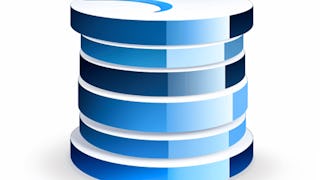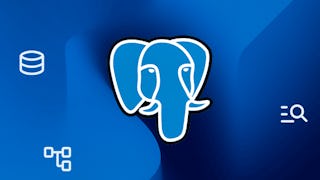In this course you will learn more about the historical design of databases and the use of SQL in the PostgreSQL environment. Using SQL techniques and common commands (INSERT INTO, WHERE, ORDER BY, ON DELETE CASCADE, etc) will enable you to create tables, column types and define the schema of your data in PostgreSQL. You will learn about data modeling and how to represent one-to-many and many-to-many relationships in PostgreSQL. Students will do hands-on assignments creating tables, inserting data, designing data models, creating relational structures and inserting and querying relational data in tables.

Enjoy unlimited growth with a year of Coursera Plus for $199 (regularly $399). Save now.

Database Design and Basic SQL in PostgreSQL
This course is part of PostgreSQL for Everybody Specialization

Instructor: Charles Russell Severance
61,597 already enrolled
Included with
(1,092 reviews)
Recommended experience
What you'll learn
Utilize psql and SQL commands to implement CRUD (Create, Read, Update, and Delete) operations for tables in a PostgreSQL database.
Identify and utilize the functions of primary, logical, and foreign keys within a database.
Build and differentiate between one-to-many and many-to-many relationships within PostgreSQL.
Recall key people, organizations, and innovations that were instrumental to building the SQL standard
Skills you'll gain
Details to know

Add to your LinkedIn profile
4 assignments
See how employees at top companies are mastering in-demand skills

Build your subject-matter expertise
- Learn new concepts from industry experts
- Gain a foundational understanding of a subject or tool
- Develop job-relevant skills with hands-on projects
- Earn a shareable career certificate

There are 4 modules in this course
In this first week, you will hear more about the goals of this course. You'll learn about the people and organizations instrumental to building the SQL standard, learn to differentiate between relational databases and flat files, and utilize psql and SQL commands to create, read, update, and delete tables in a PostgreSQL database.
What's included
8 videos6 readings1 assignment5 app items
This week, you'll learn to recall and utilize common psql commands, create a database using command line prompts, and utilize common SQL commands, including INSERT INTO, WHERE, and ORDER BY.
What's included
6 videos1 assignment2 app items
This week focuses on relational database design and one-to-many data models. You'll also learn the functions of primary, logical, and foreign keys within a database, and how to reconnect rows with corresponding data in a table.
What's included
9 videos1 assignment1 app item
The final week in this course focuses on many-to-many data models. You'll soon be able to differentiate between one-to-many and many-to-many relationships, and as well as normalize and insert data items into a connected set of many-to-many tables.
What's included
5 videos1 reading1 assignment1 app item
Earn a career certificate
Add this credential to your LinkedIn profile, resume, or CV. Share it on social media and in your performance review.
Instructor

Offered by
Explore more from Software Development
 Status: Free Trial
Status: Free TrialUniversity of Michigan
 Status: Preview
Status: Preview Status: Free Trial
Status: Free TrialUniversity of Michigan
 Status: Free Trial
Status: Free Trial
Why people choose Coursera for their career




Learner reviews
1,092 reviews
- 5 stars
85.98%
- 4 stars
10.62%
- 3 stars
1.64%
- 2 stars
0.73%
- 1 star
1%
Showing 3 of 1092
Reviewed on Dec 14, 2022
Very good course but some information is just too abstract. It need a little bit more detail and depth in order to understand concepts. The practicality of the exercises is just amazing. Great job!
Reviewed on Feb 19, 2023
Good course Very good course, easy to assimilate for a beginner, at the first "contact" with databases and things like that...
Reviewed on Jun 15, 2021
This is amazing course. In my opinion, the content of course is very concise and I can remember the important things easily
Frequently asked questions
To access the course materials, assignments and to earn a Certificate, you will need to purchase the Certificate experience when you enroll in a course. You can try a Free Trial instead, or apply for Financial Aid. The course may offer 'Full Course, No Certificate' instead. This option lets you see all course materials, submit required assessments, and get a final grade. This also means that you will not be able to purchase a Certificate experience.
When you enroll in the course, you get access to all of the courses in the Specialization, and you earn a certificate when you complete the work. Your electronic Certificate will be added to your Accomplishments page - from there, you can print your Certificate or add it to your LinkedIn profile.
Yes. In select learning programs, you can apply for financial aid or a scholarship if you can’t afford the enrollment fee. If fin aid or scholarship is available for your learning program selection, you’ll find a link to apply on the description page.
More questions
Financial aid available,





